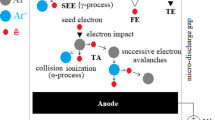Abstract
The dissolution of inhibitor layers of AHT (3-amino-5-heptyl-1,2,4-triazole) on copper wires in 0.5m H2SO4 was studied by potentiostatic current and capacity transients in a time range from 10 µs to 1000 s. The potential dependent transients show three characteristic regions corresponding to different transfer controlled processes. For short periods an almost constant current of inhibited corrosion through a metastable inhibitor layer is observed. In the second region the dissolution of this layer causes a strong increase in copper corrosion, which was taken as a direct measure of the desorption process. The electrode capacity,C, increases correspondingly. The dissolution itself is not accompanied by a notable charge transfer and, hence, cannot directly be monitored. The last region is dominated by an almost constant active copper dissolution current. The layer dissolution in the second region starts with an inhomogeneous nucleation process. Initially, holes are generated stochastically in the AHT layer and form nuclei of corrosion pits on the copper surface. Based on this model the complete transients can be calculated.
Similar content being viewed by others
Abbreviations
- b free :
-
Tafel slope of an uncovered copper electrode
- b nucl :
-
potential dependence of pit formation (Equation 23)
- b 3 :
-
b 3 = dU/d log (di pits/dt 3)
- C :
-
electrode capacity
- D :
-
dielectric constant of the layer
- D 0 :
-
dielectric constant of the vacuum
- d :
-
layer thickness
- F :
-
Faraday constant
- I 1 :
-
time dependent corrosion current of a single pit
- i :
-
total current density
- i free :
-
corrosion current density of an uncovered copper electrode
- i inh :
-
current density of an inhibited copper electrode
- i pits :
-
corrosion current density of n pits
- i 0v :
-
extrapolated value ofI free at 0 V vs SHE
- n :
-
time dependent number of pits
- n max :
-
maximum number of pits
- r :
-
time dependent radius of a single pit
- S :
-
total area of all pits t time
- U :
-
potential against SHE
- U nucl :
-
potential of hole formation
- V :
-
molar volume
- z :
-
charge number
- θ:
-
degree of coverage of inhibitor
References
K. Rittner, W. J. Lorenz, W. Paatsch, M. Kendig and F. Mansfeld,Werkst. u Korr. 36 (1985) 120.
B. E. Conway,J. Electrochem. Soc. 124 (1977) 410C.
S. Gilman,J. Phys. Chem. 67 (1963) 78;ibid. 70 (1966) 2880.
S. Trasatti and L. Formaro,J. Electroanal. Chem. 17 (1968) 343.
D. M. Drazic, V. J. Drazic and V. Jevtic,Electrochim. Acta 34 (1989) 1251.
M. M. Lohrengel,in ‘Electrochemical and Optical Techniques for the Study and Monitoring of Metallic Corrosion’, (edited by M. G. S. Ferreira, C. A. Melendres), Kluwer Academic Publishers, Fordrecht (1991) pp. 69–121.
U. König, M. Beier and J. W. Schultze,J. Electroanal. Chem. 330 (1992), 615.
M. Beier and J. W. Schultze,Electrochim. Acta 37 (1992), 2299.
Henkel KGaA, Düsseldorf, Technical information sheet, Texamin AT (1986).
J. W. Schultze, M. M. Lohrengel and D. Ross,Electrochim. Acta 28 (1983) 973.
M. M. Lohrengel and D. Ebling, Dechema Monographs, Vol. 120, VCH Verlagsgesellschaft, Weinheim (1989) p. 213.
Klaus Kluger, Diplomarbeit, Düsseldorf (1989).
U. König and M. M. Lohrengel, Dechema Monographien, Band 102, VCH Verlagsgesellschaft, Weinheim (1986) p. 99.
U. König, M. M. Lohrengel and J. W. Schultze,Ber. Bunsenges. Phys. Chem. 91 (1987) 426.
M. Avrami,J. Chem. Phys. 7 (1939) 1103;ibid. 8 (1940) 212.
H.-H., Strchblow, Habilitationsschrift, Freie Universatiät Berlin (1977).
H.-J. Engell and N. D. Stolica,Z. Phys. Chem. NF 20 (1959) 113.
J. W. Schultze,Ber. Bunsenges. Phys. Chem. 74 (1970) 705.
R. M. Wightman and D. O. Wipf, ‘Electroanalytical Chemistry’, Vol. 15, (ed. A. Bard), Marcel Dekker, New York and Basel (1989).
Author information
Authors and Affiliations
Additional information
This paper is dedicated to Professor Brian E. Conway on the occasion of his 65th birthday, and in recognition of his outstanding contribution to electrochemistry.
Rights and permissions
About this article
Cite this article
Beier, M., Lohrengel, M.M. & Schultze, J.W. Investigations of nonlinear processes by transients: kinetics of dissolution of inhibitor layers on copper. J Appl Electrochem 23, 606–614 (1993). https://doi.org/10.1007/BF00721952
Received:
Revised:
Issue Date:
DOI: https://doi.org/10.1007/BF00721952




